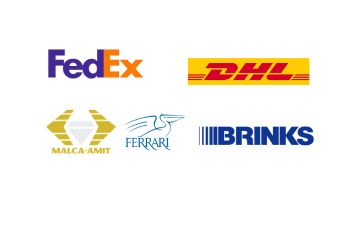
What quality criteria should I choose for my diamond?
Firstly, let us remember that the quality of a diamond is determined by the four main criteria represented by “the 4C’s”: Carat (the weight of the diamond); Color (the degrees of color); Clarity, (the degrees of purity); Cut, (the quality of the cut).
To find the diamond that perfectly matches what you are looking for, it is not important to consider all these four quality criteria. Since it is all a matter of personal taste and desire, it is possible to evaluate each criterion separately, in an approach that focuses primarily on adapting one or more of these characteristics to one's personal taste.
The most important thing to do in choosing the quality criteria opt for, when buying your diamond is to ask yourself the right questions, then set your priorities according to what best suits you.
It is all a matter of personal choice and taste, independent of pre-established standards.
On the basis of an initial budget, you will certainly have to establish a list of priorities that requires you to make certain concessions between the different criteria of weight and quality to be able to arrive at your final choice.
What carat weight should I choose for my diamond?
The weight expressed in carats is the factor that mostly influences the price of a diamond. It is also a decisive criterion when buying a diamond. These two criteria, weight and price, usually precede the choice of quality. The weight of a diamond defines its price category.
The price evolves exponentially in relation to the weight. The percentage difference in price between a 0.30 carat and a 0.40 carat diamond is smaller than the difference in price between a 0.50 and a 0.60 carat diamond. An even more surprising example: 10 diamonds of 0.10 carat, weighing a total of 1 carat, will cost 5 times less than a single 1 carat diamond of equal quality.
When choosing a carat weight, there are generally 3 options available to you:
1. Opt for the largest carat possible. This necessarily implies making concessions on quality.
2. Choose the smallest carat possible, which means focusing a very high quality.
3. The intermediate choice, also called the "good compromise" or the "good balance", which is endowed with a good intermediate quality.
What shape of diamond should I choose?
The choice of diamond shape is intimately linked to your personal desires and tastes. This criterion generally comes first in the choice of a diamond. We can simply say that the round diamond is the most popular shape in general, especially for engagement rings. This is followed by the cushion, princess, emerald and pear cut diamond shapes.
However, the financial aspect should be taken into account and can have a great influence on your choice, because there is a real difference in price between round diamonds and fancy shapes. Contrary to popular belief, fancy shapes are 15% to 35% less expensive than round diamonds depending on the shape and quality. Thus, combining originality with a good price can be a very good choice.
What quality of cut should I choose?
The quality of the cut is a very important parameter because this is what will give brilliance and sparkle to your diamond. A "lifeless" stone is immediately obvious and of less interest. We recommend that you choose, at the very least, a diamond whose cut is noted "Good" on the certificate.
What color should I choose?
While the choice of color is also a matter of personal preference, it should be noted that it is one of the most often preferred criteria alongside the weight. Indeed, the color is an easy criterion to judge and allows at first sight, even for the layman, to immediately realize the "expected effect" and to see the difference with a stone of less white color.
Note that when we talk about color for a white diamond, we are mainly talking about color intensity, shades of white whose grade is between D (exceptional white +) and Z (tinted yellow).
The criteria generally chosen are in line with the natural and rational choice of the right balance between the letters G and H (extra-white to white).
What clarity to choose for my diamond?
Although clarity is one of the most important criteria and is listed as such in the 4C's, it is still the least requested quality criterion compared to the other three. Purity, like the other criteria, plays a very important role in the price of a diamond, but unlike weight, color and cut, it is not visible to the naked eye.
Indeed, it is not possible to spot the imperfections present in the diamond with the naked eye, unless the diamond is of a very low quality. The clarities included in VS1 and SI2 are the most commonly used qualities, but here again; the right choice remains a matter of desire and balance.


























